A vertical monitor orientation, once a niche setup for coders and writers, has become a mainstream productivity tool. By rotating a standard widescreen monitor 90 degrees, users can view content that is naturally longer than it is wide—such as lines of code, web pages, legal documents, and social media feeds. This simple change can dramatically reduce scrolling and improve workflow efficiency by displaying more relevant information on the screen at once.
This guide provides a purely informational, expert-driven analysis of the vertical monitor landscape. It details the core benefits, what to look for in a display, and examines several popular models to help you understand their suitability for a portrait orientation. Before you add any display to your setup, it is fundamental to understand if you need a PC for a monitor in the first place, as functionality can vary.
Understanding the Key Benefits of a Vertical Monitor Setup
The primary advantage of a vertical monitor is increased vertical screen real estate. This is particularly beneficial for specific tasks:
- Programming and Coding: View more lines of code simultaneously, making it easier to track logic and reduce the need to scroll up and down.
- Reading and Writing: See a full page of a document or article at a glance, creating a more natural and book-like reading experience.
- Web Browse and Social Media: View long articles and feeds without constant scrolling.
- Streaming and Content Creation: A secondary vertical monitor is ideal for managing stream chats, OBS controls, or other tools while gaming or working on a primary horizontal screen. You can even learn how to make Discord open on a second monitor to streamline this process.
- Data Analysis: Work with long spreadsheets or datasets more effectively.
Key Considerations for Choosing a Monitor for Vertical Use
Not all monitors are created equal when it comes to vertical orientation. Here are the critical factors to consider.
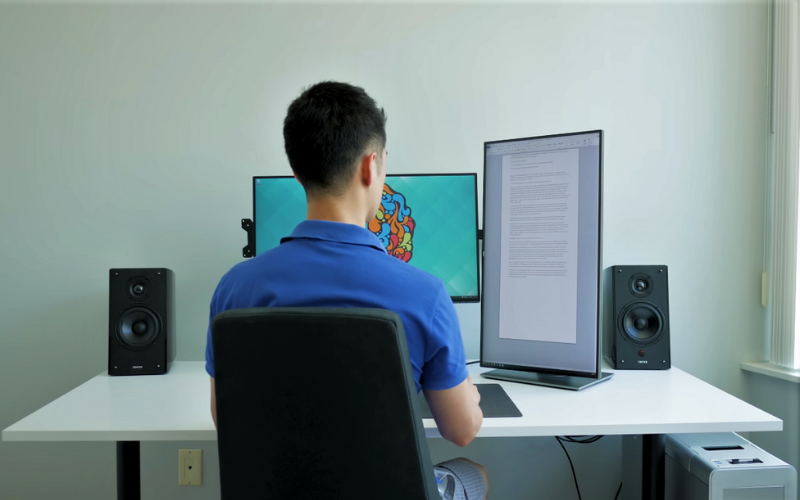
Native Pivot vs. VESA Mounting
The most important feature for a vertical setup is the ability to physically rotate the screen.
- Native Pivot: Some monitors come with a stand that is fully adjustable, including a 90-degree pivot function. This is the most straightforward solution, allowing you to switch between landscape and portrait mode without any extra hardware.
- VESA Mounting: If a monitor does not have a pivoting stand, it must be VESA compatible. This means it has a standard mounting pattern on the back (e.g., 100x100mm) that allows you to attach it to a third-party monitor arm or stand. A VESA mount offers greater flexibility and is essential for monitors with basic, non-adjustable stands. You can find options like a best dual monitor stand to create a versatile setup.
Panel Type: IPS, VA, or TN
The technology behind the screen’s panel significantly impacts viewing angles, which is critical for a vertical display.
- IPS (In-Plane Switching): This is the most suitable panel type for vertical use. IPS panels offer the widest viewing angles (typically 178°/178°) and the most consistent color accuracy. When you view an IPS monitor from the side, the colors and brightness remain largely unchanged.
- VA (Vertical Alignment): VA panels are known for their high contrast ratios, producing deep blacks. However, their viewing angles are narrower than IPS panels. When viewed off-center, you may notice color shifting, which can be more pronounced in a vertical orientation.
- TN (Twisted Nematic): TN panels have the fastest response times but the poorest viewing angles and color reproduction. They are generally not recommended for vertical use, as the color distortion from the side can be severe.
Screen Size and Resolution
The right combination of size and resolution is crucial for text clarity. A 24-inch monitor with a 1080p (Full HD) resolution is often considered a sweet spot for a secondary vertical display. For a primary vertical monitor, a 27-inch or 32-inch screen with a 1440p (QHD) or 4K (UHD) resolution will provide sharper text and more usable space. Deciding between an ultrawide vs regular monitor for your primary screen can also influence what size vertical monitor works best alongside it.
Connectivity and Ergonomics
Ensure the monitor has the necessary ports (HDMI, DisplayPort, USB-C) for your computer. For ergonomics, beyond the pivot function, look for height and tilt adjustments to position the monitor at a comfortable viewing level and prevent neck strain. Combining your monitor with one of the best ergonomic keyboard trays can further enhance your comfort during long sessions.
Comparison of Popular Vertical Monitor Models (2025)
This table provides an at-a-glance comparison of the key specifications for the monitors analyzed in this guide.
| Feature | HP 24mh | Acer R221Q | Dell S3222HG | BenQ PD3205U | ViewSonic VP3268a-4K |
| Screen Size | 23.8 inches | 21.5 inches | 31.5 inches | 31.5 inches | 32 inches |
| Resolution | 1920 x 1080 (FHD) | 1920 x 1080 (FHD) | 1920 x 1080 (FHD) | 3840 x 2160 (4K UHD) | 3840 x 2160 (4K UHD) |
| Panel Type | IPS | IPS | VA (Curved) | IPS | IPS |
| Refresh Rate | 75 Hz | 75 Hz | 165 Hz | 60 Hz | 60 Hz |
| Native Pivot Stand | Yes | No | No | Yes | Yes |
| VESA Compatible | Yes (100x100mm) | No (Adapter Req.) | Yes (100x100mm) | Yes (100x100mm) | Yes (100x100mm) |
| Brightness | 250 nits | 250 nits | 350 nits | 250 nits | 350 nits |
| Primary Use Case | Office/Productivity | Budget/General Use | Gaming | Professional/Design | Professional/Design |
| Key Connectivity | HDMI, DisplayPort, VGA | HDMI, DVI, VGA | 2x HDMI, DisplayPort | HDMI, DisplayPort, USB-C | HDMI, DisplayPort, USB-C |
Detailed Analysis of Vertical Monitor Models
Here we examine the features, strengths, and weaknesses of five distinct monitors to understand their suitability for a vertical setup.
HP 24mh FHD Monitor
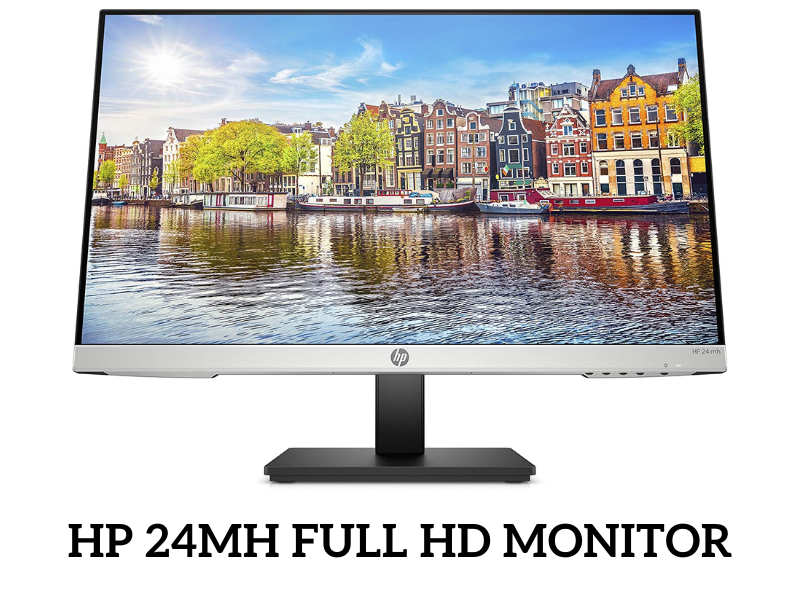
The HP 24mh is a highly popular budget-friendly monitor that is exceptionally well-suited for vertical orientation straight out of the box.
Key Specifications
- Screen Size: 23.8 inches
- Resolution: 1920 x 1080 (FHD)
- Panel Type: IPS
- Refresh Rate: 75 Hz
- Stand: Fully adjustable with Height, Tilt, Swivel, and Pivot
Design and Ergonomics
The standout feature of the 24mh is its fully ergonomic stand. It allows for 90-degree rotation into portrait mode without any additional tools or hardware. This native pivot capability is rare at this price point and is its main selling point for this use case. The monitor also features thin bezels, which makes it a good candidate for dual-monitor setups.
Display Quality and Performance
The IPS panel delivers wide viewing angles and solid color reproduction, making it perfect for vertical viewing where off-axis clarity is important. A 75Hz refresh rate provides a slightly smoother experience than standard 60Hz displays, and its low blue light mode helps reduce eye strain during long work sessions.
Connectivity
It offers a practical range of ports, including HDMI, DisplayPort, and even legacy VGA, ensuring compatibility with a wide variety of computers. It also includes built-in speakers for basic audio needs.
Suitability for Vertical Orientation
The HP 24mh is an ideal choice for anyone seeking a cost-effective and easy-to-use vertical monitor. Its combination of an IPS panel and a native pivoting stand provides immense value for productivity, coding, or as a secondary display for streaming.
Acer R221Q 21.5-inch Full HD IPS Monitor

The Acer R221Q is a common budget monitor known for its ultra-thin design and IPS panel. However, its suitability for vertical use comes with a major caveat.
Key Specifications
- Screen Size: 21.5 inches
- Resolution: 1920 x 1080 (FHD)
- Panel Type: IPS
- Refresh Rate: 75 Hz
- Stand: Tilt only
Design and Ergonomics
This monitor features a “ZeroFrame” design that looks modern and minimizes distraction. The significant drawback is its basic stand, which only offers tilt adjustment. Critically, the Acer R221Q does not have a built-in VESA mount. To use this monitor vertically, you must purchase a third-party VESA mount adapter specifically designed for this model line.
Display Quality and Performance
Like the HP, its IPS panel provides excellent viewing angles and good color quality for the price, making the screen itself suitable for portrait mode. The 75Hz refresh rate and AMD FreeSync technology make it capable of some light gaming.
Connectivity
Connectivity is limited to HDMI, DVI, and VGA ports.
Suitability for Vertical Orientation
While the display panel is appropriate for vertical use, the lack of a native pivot stand and standard VESA mount makes it a challenging option. It is only suitable for users who are willing to source and install a specific VESA adapter and a separate monitor arm. Without these additions, it cannot be used vertically.
Dell S3222HG 32-inch Curved Gaming Monitor
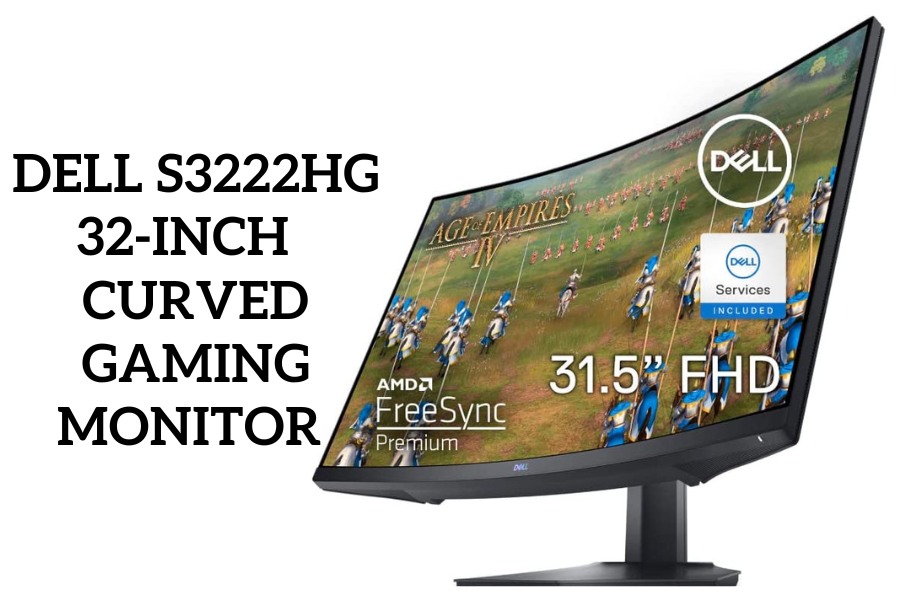
This Dell model is a large, high-refresh-rate gaming monitor that some users consider for an immersive vertical setup.
Key Specifications
- Screen Size: 31.5 inches
- Resolution: 1920 x 1080 (FHD)
- Panel Type: VA (1800R Curve)
- Refresh Rate: 165 Hz
- Stand: Height and Tilt adjustment
Design and Ergonomics
The S3222HG is designed for gaming, with an aggressive look and a prominent 1800R curvature. Its stand offers height and tilt adjustment but does not include a pivot function. However, the monitor is VESA compatible (100x100mm), so it can be mounted on an arm for vertical orientation. Exploring options like a best dual monitor wall mount can provide a stable solution.
Display Quality and Performance
As a gaming display, it boasts a fast 165Hz refresh rate and a 1ms response time mode for smooth motion. The VA panel provides a high contrast ratio for deep blacks. However, VA panels have more limited viewing angles than IPS, which can be a factor in portrait mode. The 1080p resolution on a 32-inch screen also results in a lower pixel density, which may make text appear less sharp for productivity tasks. It’s one of the sim racing monitors that focuses more on speed than pixel density.
Connectivity
It includes two HDMI ports and one DisplayPort.
Suitability for Vertical Orientation
The Dell S3222HG is a niche choice. It requires a VESA arm for vertical use, and its curved nature in portrait mode is a matter of personal preference—some find it immersive, while others find it distracting. Its primary strength is high-refresh-rate gaming, not text clarity for productivity.
BenQ PD3205U 31.5-inch 4K UHD Monitor
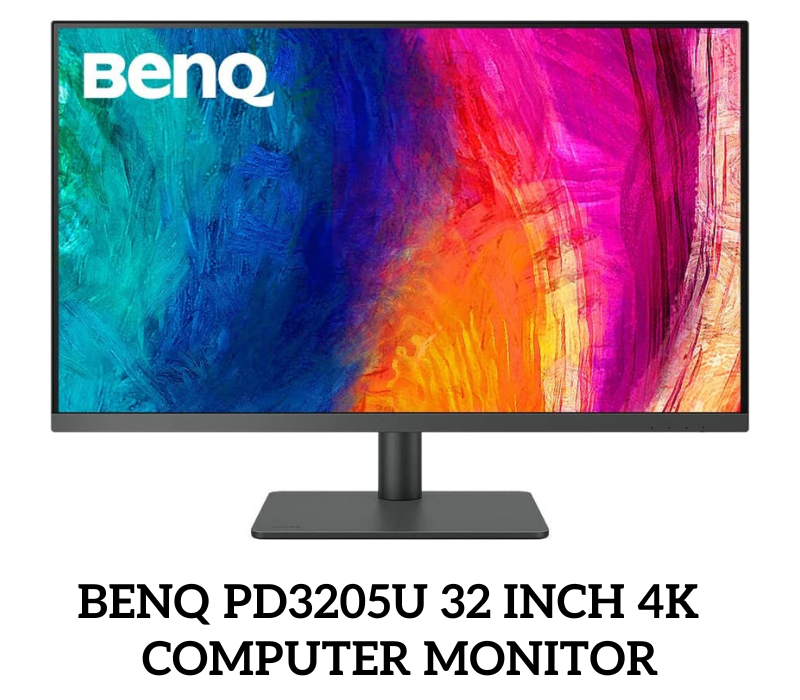
The BenQ PD3205U is a professional-grade monitor designed for designers and creators who demand color accuracy and ergonomic flexibility.
Key Specifications
- Screen Size: 31.5 inches
- Resolution: 3840 x 2160 (4K UHD)
- Panel Type: IPS
- Refresh Rate: 60 Hz
- Stand: Fully adjustable with Height, Tilt, Swivel, and Pivot
Design and Ergonomics
As a professional tool, the PD3205U comes with a robust, fully adjustable stand that includes a 90-degree pivot. The build quality is excellent, providing a stable platform in both orientations. It also includes BenQ’s Hotkey Puck, a physical controller that makes switching between display modes quick and easy.
Display Quality and Performance
This monitor delivers exceptional color accuracy, factory-calibrated to cover 99% of the sRGB and Rec.709 color spaces. The 4K resolution on a 32-inch screen provides outstanding sharpness and clarity, making it ideal for detailed work in a vertical orientation. It’s a fantastic best monitor for video editing and graphic design.
Connectivity
Connectivity is extensive, featuring HDMI, DisplayPort, and a USB-C port that supports 90W power delivery, allowing you to charge a laptop and transmit video with a single cable. A built-in KVM switch is also included, letting you control two different computers with one set of peripherals.
Suitability for Vertical Orientation
The BenQ PD3205U is an excellent choice for professionals who need a high-resolution, color-accurate display for vertical work. Its combination of a 4K IPS panel, native pivot stand, and robust connectivity makes it a top-tier productivity tool.
ViewSonic VP3268a-4K 32-inch 4K Monitor
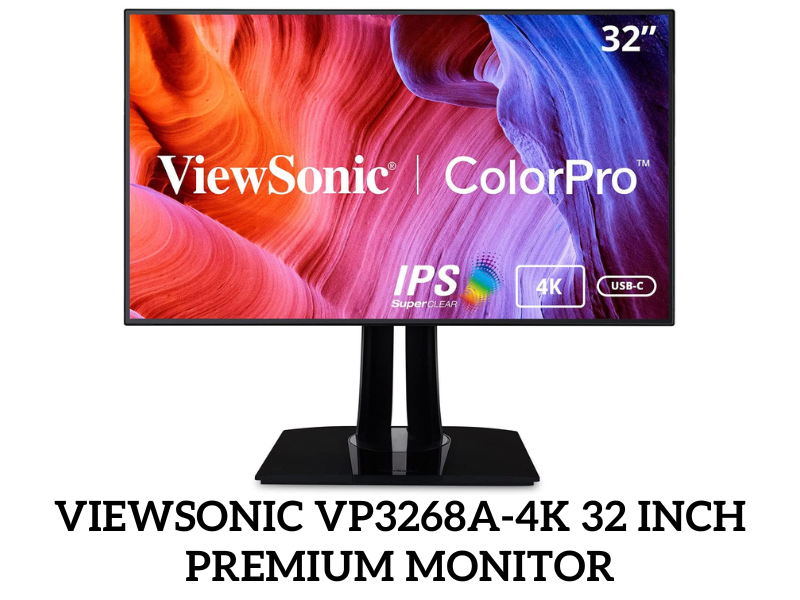
Similar to the BenQ, the ViewSonic VP3268a-4K is a professional monitor focused on delivering pristine image quality and ergonomic design for creative workflows.
Key Specifications
- Screen Size: 32 inches
- Resolution: 3840 x 2160 (4K UHD)
- Panel Type: IPS
- Refresh Rate: 60 Hz
- Stand: Fully adjustable with Height, Tilt, Swivel, and Pivot
Design and Ergonomics
The VP3268a-4K features a clean, minimalist design with a highly functional stand that provides a full 90-degree pivot. This allows for effortless switching to portrait mode. The frameless design is well-suited for multi-monitor arrangements.
Display Quality and Performance
This monitor is Pantone Validated and factory-calibrated for superior color accuracy, covering 100% of the sRGB color gamut. Its 4K IPS panel ensures that images and text are incredibly sharp and remain consistent from any viewing angle, a hallmark of a best color accurate monitor. It also includes hardware calibration capabilities for professionals who require precise color management.
Connectivity
It offers a comprehensive set of ports: HDMI, DisplayPort, and USB-C with 90W power delivery. It also includes an integrated USB hub for connecting peripherals directly to the monitor.
Suitability for Vertical Orientation
The ViewSonic VP3268a-4K is a direct competitor to the BenQ PD3205U and is an equally strong choice for professionals. Its superb color accuracy, 4K resolution, and fully ergonomic stand make it a premier option for anyone doing serious creative work in a vertical orientation.
How to Set Up a Monitor in a Vertical Orientation
Once you have a suitable monitor, setting it up vertically is a two-step process:
- Physical Rotation: If your monitor has a native pivot stand, simply lift it to its highest point and rotate the screen 90 degrees. If you are using a VESA arm, ensure it is securely mounted to your desk and the monitor, then rotate it. You may wonder, “can you mount a computer monitor on the wall?”, and the answer is yes, with the right VESA-compatible hardware.
- Display Settings Adjustment: Your operating system will not automatically detect the rotation. You need to adjust this in the settings.
- In Windows 11: Right-click the desktop, select “Display settings,” choose the correct monitor, scroll down to “Display orientation,” and change it from “Landscape” to “Portrait.”
- In macOS: Open “System Settings,” go to “Displays,” select your monitor, and find the “Rotation” option. Change it to “90 degrees.”
Frequently Asked Questions (FAQ)
Can any monitor be used vertically?
No. A monitor can only be used vertically if it either has a stand with a native 90-degree pivot function or if it is VESA mount compatible, which allows it to be attached to a third-party arm or stand that offers rotation. Monitors without either of these features cannot be physically oriented vertically.
Is a curved monitor good for vertical use?
This is subjective. When a curved monitor is turned vertically, the curve runs horizontally. Some users find this creates an odd “hugging” or wrapping effect that can be distracting, while a few find it immersive. For tasks that require straight lines, like graphic design or spreadsheets, a flat monitor is generally considered more suitable for vertical orientation.
What is the ideal screen size for a vertical monitor?
For a secondary vertical monitor used for chat or supplementary information, 22 to 24 inches at 1080p resolution is very effective. For a primary vertical monitor used for coding or document editing, a 27-inch 1440p (QHD) or a 32-inch 4K (UHD) monitor provides better text clarity and more usable screen space.
Are vertical monitors good for gaming?
Vertical monitors are generally not used for playing games. Most games are designed for a wide, landscape aspect ratio. A vertical orientation would severely crop the field of view. However, a secondary vertical monitor is extremely popular among gamers, especially streamers, for managing chat, viewing system performance with a best CPU temp monitor tool, or keeping a guide open.
How does a vertical monitor improve productivity for programmers?
Programming involves writing and reading long columns of text. A vertical monitor displays significantly more lines of code on the screen at one time compared to a horizontal one. This allows programmers to see more of a function or file at once, reducing the need to scroll and helping them maintain mental context while working.
Does a vertical monitor occupy less space?
Yes, a vertical monitor has a smaller horizontal footprint on a desk compared to when it is in landscape mode. This can free up valuable desk space for speakers, notebooks, or other peripherals, and it makes fitting a dual-monitor or triple-monitor setup easier.

With 15 years of experience as a PC hardware technician, Ben brings a practical, hands-on approach to our PC Components section. He specializes in real-world testing and longevity analysis, explaining how components perform over time. His guides help readers understand the practical side of owning and maintaining a gaming PC.
